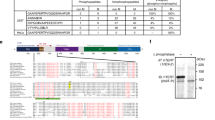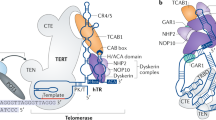Abstract
The expression of telomerase, the enzyme that synthesizes telomeric DNA de novo, is suppressed in normal somatic human cells but is reactivated during tumorigenesis. This reactivation appears to arrest the normal loss of telomeric DNA incurred as human cells divide. Since continual loss of telomeric DNA is predicted to eventually limit cell proliferation, activation of telomerase in cancer cells may represent an important step in the acquisition of the cell immortalization which occurs during tumor progression. The telomerase holoenzyme is composed of both RNA and protein subunits. In humans, mRNA expression of hTERT (hEST2), the candidate telomerase catalytic subunit gene, appears to parallel the levels of telomerase enzyme activity, suggesting that induction of hTERT is necessary and perhaps sufficient for expression of telomerase activity in tumor cells. To test this model directly, we ectopically expressed an epitope-tagged version of hTERT in telomerase-negative cells and show that telomerase activity was induced to levels comparable to those seen in immortal telomerase-positive cells and that the expressed hTERT protein was physically associated with the cellular telomerase activity. We conclude that synthesis of the hTERT telomerase subunit represents the rate-limiting determinant of telomerase activity in these cells and that this protein, once expressed, becomes part of the functional telomerase holoenzyme.
This is a preview of subscription content, access via your institution
Access options
Subscribe to this journal
Receive 50 print issues and online access
$259.00 per year
only $5.18 per issue
Buy this article
- Purchase on Springer Link
- Instant access to full article PDF
Prices may be subject to local taxes which are calculated during checkout
Similar content being viewed by others
Author information
Authors and Affiliations
Rights and permissions
About this article
Cite this article
Counter, C., Meyerson, M., Eaton, E. et al. Telomerase activity is restored in human cells by ectopic expression of hTERT (hEST2), the catalytic subunit of telomerase. Oncogene 16, 1217–1222 (1998). https://doi.org/10.1038/sj.onc.1201882
Received:
Revised:
Accepted:
Published:
Issue Date:
DOI: https://doi.org/10.1038/sj.onc.1201882
Keywords
This article is cited by
-
Integrated analysis of telomerase enzymatic activity unravels an association with cancer stemness and proliferation
Nature Communications (2021)
-
Telomerase reverse transcriptase downregulation by RNA interference modulates endoplasmic reticulum stress and mitochondrial energy production
Molecular Biology Reports (2020)
-
Matrix Production in Chondrocytes Transfected with Sex Determining Region Y-Box 9 and Telomerase Reverse Transcriptase Genes: An In Vitro Evaluation from Monolayer Culture to Three-Dimensional Culture
Tissue Engineering and Regenerative Medicine (2019)
-
Telomeres and telomerase in prostate cancer development and therapy
Nature Reviews Urology (2017)
-
Systematic analysis of telomere length and somatic alterations in 31 cancer types
Nature Genetics (2017)



